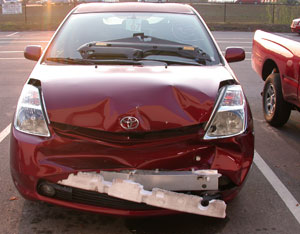 by Paul Bailey
by Paul Bailey
In these times of soaring fuel prices, dozens of hybrid vehicles are on the market — and actually selling — and dozens more, currently in the development stages, are expected to go into production soon. Their increasing popularity makes it imperative that you have a thorough understanding of them — and of how to safely work on them.
Defining EVs and HEVs
The main difference between electric vehicles (EVs) and hybrid electric vehicles (HEVs) is rather simple:
• EVs are powered by a rechargeable high-voltage battery pack and propelled by an electric motor. Due to the limitations of the power supply and the electric motor, EVs are limited in terms of power, speed and the range of distance they can travel before requiring recharging of the power supply from an outside source.
• HEVs rely on a combination of an electric motor and an internal combustion (IC) engine. HEVs also have a rechargeable high-voltage battery pack to power the electric motor, but they don’t rely on external charging. The battery pack is recharged by an onboard generator that’s powered either by the IC engine or by the kinetic energy produced when the vehicle is coasting. Therefore, HEVs don’t suffer the same limitations in power, speed and range of travelable distance as their electric counterparts.
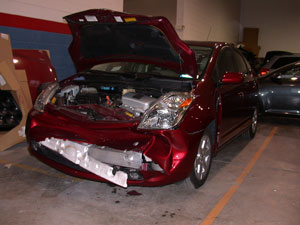 Electric Motors Powering Hybrids
Electric Motors Powering Hybrids
Two types of electric motors can be used:
• A DC electric motor produces its maximum torque the moment it starts at zero RPMs. As the RPMs increase, the motor produces less torque. This decreasing torque curve limits the maximum RPM output of the DC motor, limiting the maximum speed of the vehicle. DC motors also have a limited lifespan. Brushes contact a moving armature inside the motor and have a tendency to wear out after continued exposure to the heat generated by the movement.
Since DC motors are also larger, heavier and more expensive to build than AC motors, they aren’t an efficient choice of propulsion method. DC motors are typically used in low-speed, short-distance vehicles with a rechargeable power source, such as a golf cart.
• A three-phase AC induction motor is the most common electric motor used in EVs and HEVs. AC motors have no moving parts inside to wear out, so they offer a longer lifespan than DC motors. AC motors produce power more efficiently than DC motors, and the three-phase AC motor is more efficient than a single-phase AC motor. AC motors are also capable of turning a much higher rate of RPMs than DC motors. Like DC motors, AC motors produce a near maximum torque level at zero RPMs. However, three-phase AC induction motors used in EVs and HEVs consistently produce near maximum torque at up to about 7,000 RPMs. AC motors are also much more tolerant of heat than their DC counterparts.
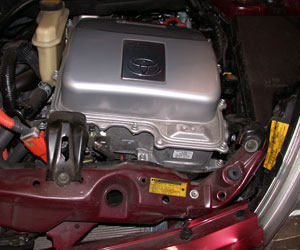 Characteristics of Hybrid Batteries
Characteristics of Hybrid Batteries
Let’s consider some of the char-acteristics required of the batteries used to provide power to an EV or HEV motor:
• Voltage — is among the most important characteristics of these batteries. High-voltage battery packs generally consist of a series of smaller, lower-voltage batteries connected together to achieve the higher voltage. Higher voltage is important because the higher the battery voltage, the more propulsion power the motor will be able to deliver.
On the other hand, the higher the voltage of the battery pack, the higher the number of batteries that will be required. More batteries will, in turn, increase battery pack size and weight, and increased weight will increase the amount of power required to propel the vehicle. Most EVs and HEVs available have battery packs ranging from about 40 to more than 300 volts.
• Battery energy content — is the total amount of energy the battery can store and provide to the motor.
• Battery-specific energy – determines the potential range of distance achievable before recharging is required.
• Battery specific power — is the amount of immediate power the battery is capable of delivering to the motor. It determines both the rate at which the vehicle can accelerate and the top speed achievable.
• Battery cycle life — refers to the number of times a battery can be discharged and recharged before it no longer holds its charge and requires replacement. This is important, obviously, because the battery packs installed in EVs and HEVs go through continuous cycles of discharge and recharge. A long cycle life is necessary for the battery pack to last for years without requiring replacement.
• Operating temperature range — is important since the car battery will be exposed to below-freezing climates as well as 100-plus degree temperatures. Batteries, like humans, operate best when the surrounding temperature is within a certain range. Warmer or cooler temperatures can be tolerated, but performance is altered by the change in temperature.
• Self-discharge rate — is the rate at which a battery loses some of its charge over time, even if the battery is in storage with no load applied. Different battery types have different rates. It’s important to remember that battery packs in EVs and HEVs will self-discharge when not in use and should be charged periodically.
When the vehicle remains parked for an extended period of time, it may lose some of its battery power.
Batteries Used in Hybrids
Three types of rechargeable batteries have been used in EVs and HEVs: lead acid, nickel-metal hy-dride and lithium-based.
1. Regular lead acid batteries possess a high level of specific power. Remember, specific power is the amount of immediate power the battery is capable of delivering to the electric motor. Lead acid batteries are lower in cost than other types of batteries used in EVs and HEVs.
They also have the lowest self-discharge rate. A lead acid battery can sit for a couple of months and lose very little of its stored charge. Like most batteries, lead acid batteries perform best in moderate temperatures, but they have a high tolerance of hot and cold temperatures.
On the downside, lead acid batteries have a low specific energy level and are large and heavy. Because of this, a lead acid battery pack would limit the range of distance and speed at which the vehicle could travel. Lead acid batteries also have a relatively short lifespan that’s shortened even more when the battery is completely discharged. Most lead acid batteries can only be charged and discharged a few hundred times before losing the ability to hold a charge. In addition, even though they’re recyclable, the lead is an environmental hazard.
2. Nickel-metal hydride (NiMH) batteries have more specific power and more specific energy than lead acid batteries. Nickel batteries can have three to four times the cycle life of lead acid batteries.
On the downside, their cycle life is significantly reduced in hot climates where temperatures regularly exceed 100 degrees F. Performance is also limited in cold temperatures below 32 degrees. Also, nickel batteries generally cost about four times as much as a comparable lead acid battery and have a much higher self-discharge rate. Since nickel battery packs in EVs and HEVs have a self-discharge rate of about 30% per month, a vehicle that’s left parked for more than a couple of months will most likely have a discharged battery pack and won’t run.
3. The two most commonly used lithium-based batteries in EVs and HEVs are lithium-ion and lithium-polymer. Lithium batteries have the highest specific energy and the highest specific power levels of all the batteries considered for vehicle production. They also have a very low self-discharge rate, similar to that of lead acid batteries. And unlike other batteries, lithium batteries suffer no loss of lifespan when they’re completely discharged.
On the downside, of all the batteries considered for vehicle production, lithium batteries are the most expensive to manufacture. And while they have a good cycle life, the components in them have a relatively short calendar life. Lithium-ion batteries wouldn’t last as long as most people keep their vehicles and would be expensive to replace. Lithium-polymer batteries have a more acceptable lifespan but require a higher operating temperature of 140 to 200 degrees. This would require an extended warmup time that limits use in cold climates.
The volatility of lithium batteries is also an issue. If a lithium battery is shorted or punctured or if the vehicle catches fire and the battery pack is exposed to extreme heat, it may explode. While some manufacturers are developing vehicles with lithium battery packs, nickel batteries are the most commonly used power supply in currently mass-produced EVs and HEVs.
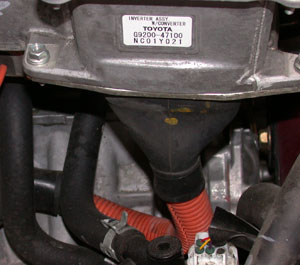 Powering an EV
Powering an EV
So how does a DC power source run an AC electric motor? The electric current from the battery is passed through an inverter before it goes to the motor, and the inverter changes DC current into AC current, and vice versa. Electricity produced by an onboard generator or by the electric motor acting as a generator is also passed back through the inverter to the battery pack to maintain a sufficient charge to power the electric motor.
EVs also have a transformer, called a converter, that converts the high power from the battery pack to 12 volts. The 12-volt power supply from the converter provides power to the vehicle’s standard 12-volt lead acid battery to maintain a full charge. The 12-volt battery stores the charge and provides power to the electrical system that operates 12-volt accessories, such as lights, a radio, power windows, etc. Computerized control modules that work in conjunction with the inverter and converter regulate the flow of all the different voltages and types of electrical current.
When the vehicle is coasting or when the driver is braking, the computerized control module stops the inverter from feeding electricity into the electric motor. The inverter becomes a load that draws electricity from the motor while the motor becomes a generator. The kinetic energy produced by the moving vehicle turns the electric motor, producing electrical energy that’s supplied to the inverter and fed back to the high-voltage battery pack. This is called regenerative braking.
Because regenerative braking won’t provide enough electrical energy to maintain a sufficient state of charge in the high-voltage battery pack, EVs will require an external source of recharging. HEVs, on the other hand, rely on the internal combustion engine to drive the vehicle a sufficient portion of the time to maintain the battery pack’s required state of charge.
Powering an HEV
So far, I’ve focused primarily on the electric portion of the drive train, but now let’s explore the function of the electric motor in conjunction with the IC engine. The IC engine may propel the vehicle or it may run a generator that supplies electricity to the electric motor and the battery pack. In many hybrids, the IC engine performs both functions. In a full hybrid, the electric motor is capable of propelling the vehicle on its own, while in a mild hybrid, the electric motor only assists the IC engine.
There are several ways to configure HEVs. We’ll discuss three of them.
1. Series hybrid — The IC engine is used to drive a generator that supplies power to charge the high-voltage battery pack that drives the electric motor. This is called a series configuration because the power flows through a series of components from the IC engine to the generator, to the battery pack, to the electric motor, to the transmission and, finally, to the wheels. Series hybrids are generally considered the only full hybrids; other configurations are considered mild hybrids.
The series hybrid was the original idea behind the conversion from full EV to HEV; the IC engine and generator provided an on-board method of recharging the battery pack that powered the motor that propelled the vehicle. This increased the achievable range of distance available to the vehicle.
Few series configured hybrids are currently in use or available for sale to the public. Some are utilized at airports, small cities and large amusement parks in localized transportation systems. At the 2006 North American International Auto Show, however, Mitsubishi introduced a new series hybrid, the concept “CT,” featuring individual electric motors that drive each of the four wheels. The “CT” incorporates technology somewhat similar to that originally utilized by Ferdinand Porsche in the design and construction of the original Lohner Porsche.
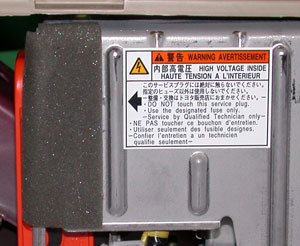 2. Parallel hybrid — Another common configuration is called a parallel hybrid, in which the IC engine is capable of directly propelling the vehicle. In the parallel configuration, the power may flow from the IC engine to the transmission, to the wheels, or it may flow from the battery pack to the electric motor, to the transmission, to the wheels. In a parallel hybrid, the electric motor may assist the IC engine when propelling the vehicle or it may switch over to perform as the generator that charges the battery pack. When the electric motor is contributing to the propulsion of the vehicle, it uses the battery pack as its only power source. The electric motor may act as a generator to charge the battery pack when the vehicle is coasting, or the IC engine may turn the motor to charge the battery pack when the vehicle is sitting still.
2. Parallel hybrid — Another common configuration is called a parallel hybrid, in which the IC engine is capable of directly propelling the vehicle. In the parallel configuration, the power may flow from the IC engine to the transmission, to the wheels, or it may flow from the battery pack to the electric motor, to the transmission, to the wheels. In a parallel hybrid, the electric motor may assist the IC engine when propelling the vehicle or it may switch over to perform as the generator that charges the battery pack. When the electric motor is contributing to the propulsion of the vehicle, it uses the battery pack as its only power source. The electric motor may act as a generator to charge the battery pack when the vehicle is coasting, or the IC engine may turn the motor to charge the battery pack when the vehicle is sitting still.
In parallel hybrids, the electric motor can take the place of the conventional 12-volt starter and the alternator system used in IC engine-only vehicles. When the vehicle is sitting still and the battery pack is sufficiently charged, the IC engine shuts off to save fuel. When it’s necessary to use the IC engine, the electric motor can turn the IC engine over and start it.
Some hybrids also have an auxiliary 12-volt starter that can start the IC engine if the battery pack is low, and the electric motor can still perform the function of the standard 12-volt alternator. HEVs with this parallel configuration are generally considered mild hybrids, since vehicle propulsion requires the use of the IC engine along with the electric motor.
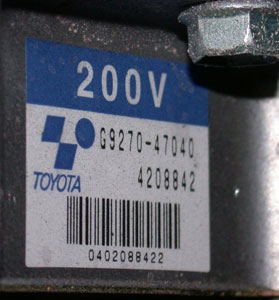 Honda’s Insight and Civic hybrids are parallel configured mild hybrids. Honda calls the powertrain on these hybrids the Integrated Motor Assist (IMA) system. The IMA system is a mild hybrid design and isn’t capable of electric motor-only propulsion. The high-voltage battery pack, inverter, converter and control modules in these vehicles are contained in a module called the intelligent power unit (IPU) that also has a cooling fan installed.
Honda’s Insight and Civic hybrids are parallel configured mild hybrids. Honda calls the powertrain on these hybrids the Integrated Motor Assist (IMA) system. The IMA system is a mild hybrid design and isn’t capable of electric motor-only propulsion. The high-voltage battery pack, inverter, converter and control modules in these vehicles are contained in a module called the intelligent power unit (IPU) that also has a cooling fan installed.
3. Combination hybrid — A combination hybrid configuration is considered a full hybrid and combines the characteristics of both series and parallel configurations. With this configuration, power can flow from the fuel tank to the IC engine, to the transmission and to the wheels, or it can flow from the battery pack to the electric motor, to the transmission and to the wheels. Vehicles with this configuration have two electric motors.
The IC engine or the larger of the two electric motors can directly propel the vehicle. The small electric motor is turned by the IC engine and functions primarily as a generator to charge the battery pack or to provide power to the large electric motor. It only functions as a motor when it turns the IC engine over to start it.
A power split device is also used in this configuration to allow the IC engine and the two electric motors to operate together or independently of each other. The power split device allows the IC engine and each electric motor to turn at different RPMs. This allows the IC engine, generator and electric drive motor to operate within their own most efficient range at all times.
The Toyota Prius and Ford Escape are two examples of this configuration. Unlike Honda’s IPU, the Prius’ inverter and converter are in a separate location not directly installed with the battery pack.
Before Starting Repairs
Time for the hands-on portion of this article: You’ve been assigned an HEV to repair and don’t repair these vehicles very often, but it’s just another wrecked car, right?
Wrong.
When repairing an HEV, always take certain precautions before starting repairs. For starters, it’s best to assume that the vehicle’s high-voltage system is always charged. HEVs usually have hundreds of volts in the high-voltage system — which could easily kill you — so it’s important to follow safety precautions.
The most valuable and most important piece of safety equipment you should use when working around the high-voltage systems of hybrids is a pair of insulated rubber linemen’s gloves. Use class 0 rated gloves, which are solid black in color, and make sure they’re never wet when you put them on. Also, blow them up to leak check them for any holes or tears to ensure your skin doesn’t come in contact with high-voltage system components.
Another important tool is a digital volt-ohm meter (DVOM) capable of reading mega-ohms. You can use the DVOM to check components for the existence of high voltage. You can also check the metal of the vehicle’s body or structure to ensure that the high-voltage system is insulated and that no voltage is passing through other parts of the car as a result of pinched or cut wires.
You also want to make sure that the fire extinguishers in your shop are class ABC-rated extinguishers, suitable for use on ordinary combustibles, flammable liquids or electrical fires. Never throw water on an electrical fire. Water on electrical fires, like water on flammable liquid fires, will do more harm than good and will likely spread the fire to a larger area.
If any damage to the high-voltage battery pack has occurred, open all the car doors as well as the shop doors and keep a fan blowing on the car. The electrolyte from nickel-metal hydride (NiMH) batteries is alkaline and can react with aluminum or other reactive metals to produce hydrogen gas. If a car is filled with hydrogen gas, it only takes one small spark to cause an explosion. Proper ventilation of the vehicle will reduce the risk of such an explosion.
If you notice any liquid spills around the area of the high-voltage battery pack, address them immediately. With the vehicle and the shop open and well-ventilated, disable the high-voltage system. Use litmus paper to determine the pH level of the liquid. The pH level will tell you whether the liquid is acidic, alkaline or neutral. Lead acid battery electrolyte is acidic, while NiMH battery electrolyte is alkaline. Plain water is considered neutral.
Because battery electrolyte is caustic, you don’t want it coming in contact with your skin or eyes. It’s a good idea to wear acid- and alkali-resistant gloves, goggles and aprons or coveralls while you neutralize and clean up electrolyte spills.
Battery companies, environmental supply companies and industrial supply companies will have spill kits available for battery electrolyte spills. These kits come complete with litmus paper and instructions for determining the pH level of a spilled liquid. These companies also supply products for neutralizing spills. As most of us already know, baking soda or ammonia can be used to neutralize an electrolyte spill from a lead acid battery. But for NiMH electrolyte spills, boric acid powder mixed with water should be used. If no boric acid is available, you can use vinegar. The best place to find boric acid powder is in highly concentrated (95 to 100% boric acid) roach-killing powders.
Disabling the High-Voltage System
If you’ll be welding on a hybrid, the manufacturers recommend that you disable the high-voltage system. Service or owners’ manuals contain specific instructions for disabling each individual HEV model. Remember, some HEVs may also have a required waiting period between disabling the high-voltage system and beginning repairs; after the battery pack is disabled, the condensers in the inverter may continue to store the high voltage for several minutes.
Depending on which make and model you’re working on, there may be more than one way to disable the high-voltage system. And depending on the location and type of damage, you may or may not have access to one method or the other. If possible, it’s always a good idea for safety reasons to use more than one method to disable the high-voltage system.
For example, there may be a switch or a terminal that connects directly to the battery pack, but there may also be a fuse or relay in the fuse block under the hood that can also be removed to disable the system. Use both methods whenever possible. For safety reasons, put the removed fuse or relay in your pocket or in your toolbox, out of sight.
This will prevent others from installing the fuse or relay to move the vehicle and return it to your work area while you’re out to lunch or something. If you return and resume work on the vehicle without knowledge of the voltage in the enabled system, the result could be fatal.
You can use welding blankets to cover the high-voltage battery pack to protect it from heat or sparks, but if you’re going to be working within 10 to 12 inches of the battery pack, it may be better to remove the battery pack. Some battery packs require special equipment for removal, and one person alone cannot remove some battery packs due to their size and weight.
Remember, the lifespan of NiMH batteries is extended by maintaining the state of charge within 60 to 80% of its full capacity at all times. These vehicles are designed to never let the battery pack reach full charge or full discharge. If the battery pack is fully discharged, there may be no way to recharge it. Some HEVs can only recharge the battery pack by running the internal combustion (IC) engine. For this reason, if you expect to wait awhile for back-ordered parts or if for any reason at all the vehicle might not be started and run for some time, it may be better to wait until you have everything you
need to complete the repairs before beginning.
NiMH batteries have a self-discharge rate of about 30% per month. HEV owners who expect to be out of town for six to eight weeks or more are advised to have a friend drive the vehicle once a week to maintain the required 60 to 80% state-of-charge in the high-voltage battery pack. If possible, you should run the IC engine 20 to 30 minutes once a week while you wait for a back-ordered part or settle a dispute with an insurer. Also, remember that temperatures of 150 degrees or more can damage NiMH batteries. Be sure your painters are baking cars in the booth at 140 degrees or less.
Also, take care not to overcharge the high-voltage battery pack by pushing the vehicle and turning the wheels. If a hybrid car is towed, it must be moved on a rollback truck. If it must be pushed or pulled more than 20 feet, set it up on wheel dollies to move it. Even with the high-voltage battery pack disconnected, turning the wheels turns the generator that feeds electricity into the condensers in the inverter. If any of the high-voltage cables are cut or exposed or if there’s a short somewhere in the high-voltage system, this could lead to injury or fire.
After you’ve disabled the high-voltage system and thoroughly inspected the battery pack for damage, inspect the rest of the high-voltage system for damage. Inspect the high-voltage cables, particularly in the area of the collision damage. The high-voltage cables are nearly always bright orange in color and in many areas are encased in protective harnesses. If you notice any bare cables or pinched or damaged cables, use your DVOM to measure for voltage. If no voltage exists, temporarily protect the cables with vinyl electrical tape until the cables can be replaced. ALL damaged high-voltage cables must be replaced regardless of the extent of damage.
You Can’t Stop Progress
In the never-ending pursuit of improved technology, there will always be something new coming down the road — and eventually into your shop. Obviously, you can’t stop progress, but you can keep up with new technology as it hits the market. Hybrids, in one form or another, are here to stay. Be safe and learn everything you can about repairing
them.
Author Bio
Writer Paul Bailey, a contributing editor to BodyShop Business, has been a collision repairman for more than 20 years and is an avid photographer, writer and artist. Currently at work on what he expects to be his first book, Bailey resides in Florida with his wife, Cathy..


